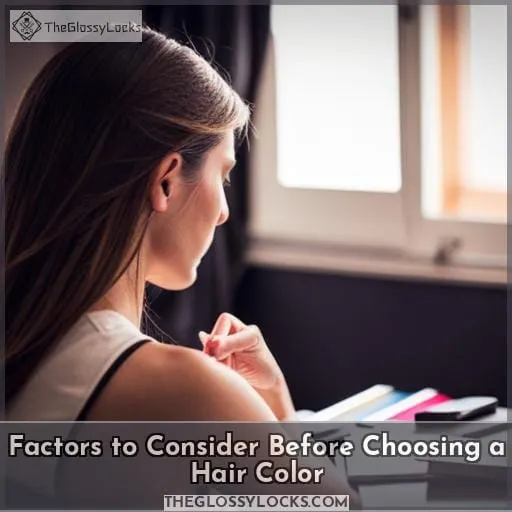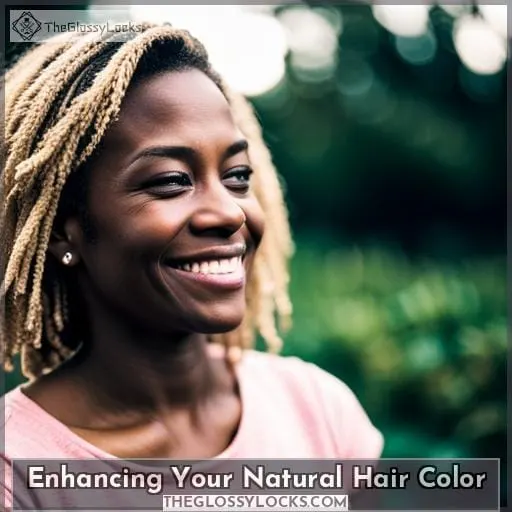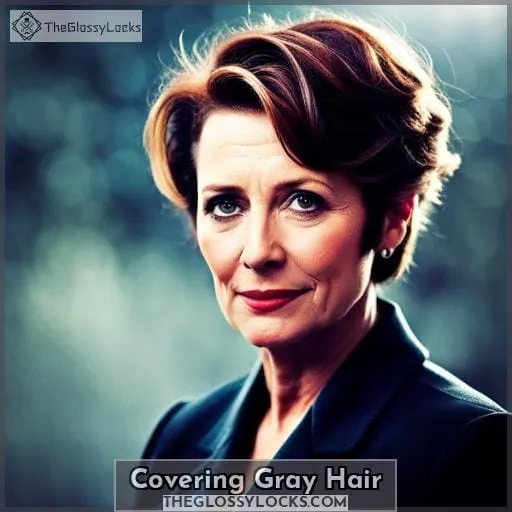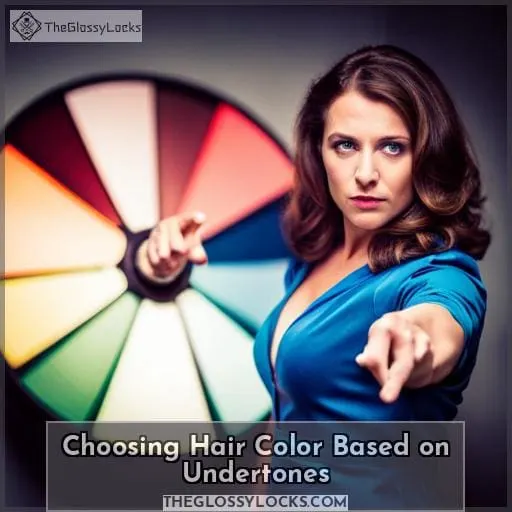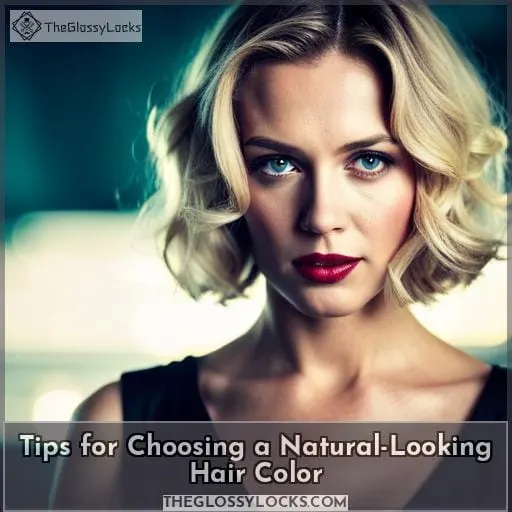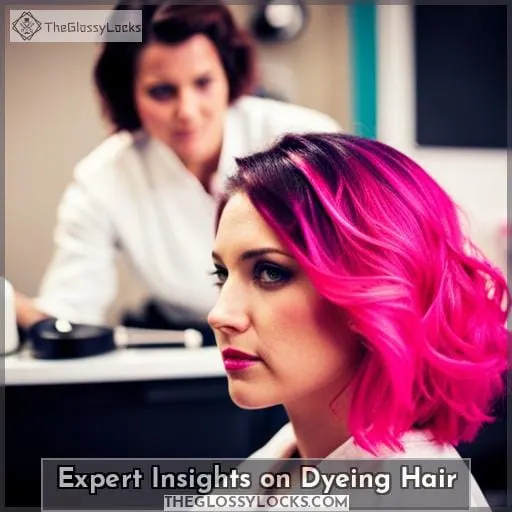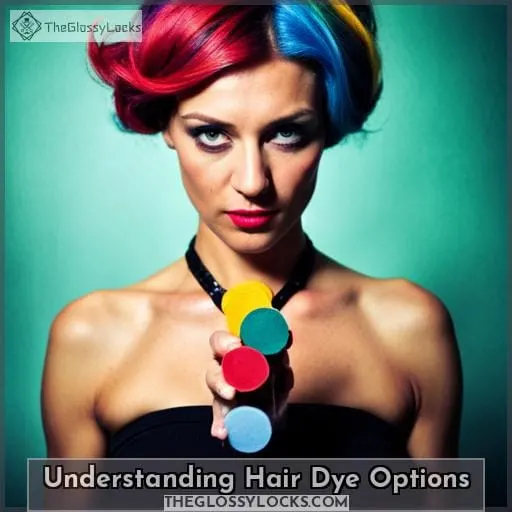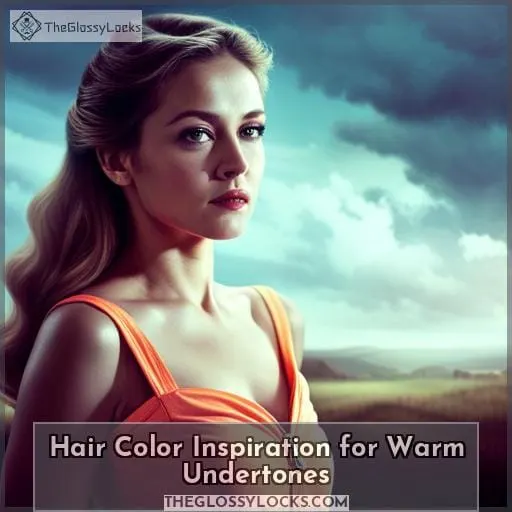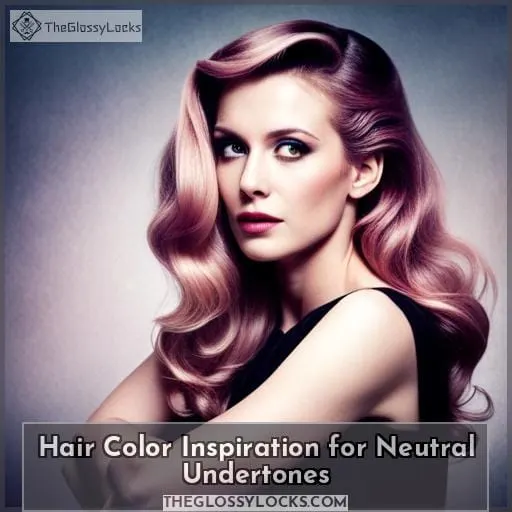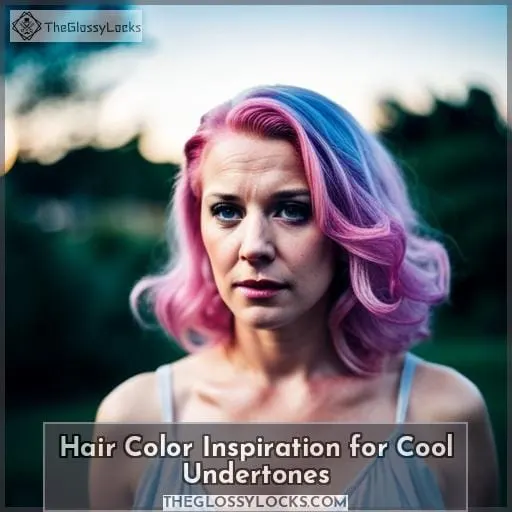This site is supported by our readers. We may earn a commission, at no cost to you, if you purchase through links.

We’ve got all the expert tips and inspiration you need to find your ideal shade.
Whether you want to enhance your natural hue, cover those pesky grays, or try something completely new, we’ve got you covered.
Get ready to unleash your inner style icon with a stunning new hair color that reflects who you truly are.
Let’s dive in and find out what color should dye YOUR hair!
Table Of Contents
- Key Takeaways
- Factors to Consider Before Choosing a Hair Color
- Enhancing Your Natural Hair Color
- Covering Gray Hair
- Choosing Hair Color Based on Undertones
- Tips for Choosing a Natural-Looking Hair Color
- Expert Insights on Dyeing Hair
- Understanding Hair Dye Options
- Hair Color Inspiration for Warm Undertones
- Hair Color Inspiration for Neutral Undertones
- Hair Color Inspiration for Cool Undertones
- Frequently Asked Questions (FAQs)
- How can I maintain my hair color and prevent it from fading?
- Are there any precautions I should take before dyeing my hair, such as doing a patch test?
- Can I dye my hair at home or should I always go to a professional colorist?
- What are some temporary hair color options that I can try before committing to a permanent dye?
- Are there any specific hair care products or treatments that can help preserve the color and health of my dyed hair?
- Conclusion
Key Takeaways
- Consider the impact of hair color on hair texture and health.
- Evaluate the desired change in relation to your current natural hair color.
- Determine which colors complement your skin’s undertones for a harmonious look.
- Factor in your commitment level and willingness to maintain the color.
Factors to Consider Before Choosing a Hair Color
Before choosing a hair color, there are several factors you should consider.
First, take into account your hair texture and health to minimize damage and maintain its overall condition.
Additionally, consider both your current and natural hair color as this can affect the outcome of dyeing.
Lastly, take into consideration your skin tone and undertones to choose a shade that complements your complexion.
Finally, evaluate your commitment level and ability to upkeep the chosen color for long-lasting results.
Hair Texture and Health
Consider your hair texture and health when choosing a hair color.
To achieve healthy locks, focus on moisture balance and scalp care.
Prioritize repairing any damage before undergoing a texture transformation.
Take our hair color quiz for personalized tips and color inspiration!
Current and Natural Hair Color
Are you wondering how your current and natural hair color impacts the choice of hair color?
Your current hair color serves as a canvas for the desired shade, while considering factors such as undertones, skin tone, and tonal harmony.
Understanding these elements will help achieve a seamless transition and create stunning color contrast.
Skin Tone and Undertones
Now let’s delve deeper into understanding your skin tone and undertones when choosing a hair color, as it greatly impacts the final result.
Consider undertone harmony, color contrast, vein analysis, eye coordination, and childhood influences for a personalized hair color guide that enhances your natural shade.
Commitment Level and Upkeep
Before choosing a hair color, assess your commitment level and consider the upkeep required.
- Color Maintenance: Think about how much time and effort you’re willing to put into maintaining your chosen shade. Some colors require more frequent touch-ups or specialized products for proper maintenance.
- Longevity Considerations: Different types of dyes have varying lifespans on the hair before fading or needing touch-ups. Semi-permanent dyes typically last around eight washes, while permanent dyes can last six to eight weeks.
- Upkeep Challenges: Certain colors may require more regular trips to the salon for touch-ups or specific care routines at home, such as using color-safe shampoo and conditioner or avoiding heat styling tools that could fade vibrant shades faster.
- Commitment Evaluation: Be honest with yourself about how committed you’re willing to be when it comes to caring for colored locks regularly over an extended period of time before making any drastic changes.
By carefully evaluating these aspects like time commitments, budget considerations along with the longevity of the color, you can make an informed decision about which hair color is right for you.
Enhancing Your Natural Hair Color
Enhancing your natural hair color can be achieved through various methods, such as using a hair glaze or a hair gloss.
A hair glaze provides a temporary shine coating that lasts for just a few washes, while a hair gloss subtly enhances your natural color and corrects undertones for up to 20 washes.
Both options offer results close to your natural shade and can help you achieve the desired level of enhancement without committing to permanent dye.
Hair Glaze
To enhance your natural hair color, consider using a hair glaze.
Hair glazes provide glossy transformations and temporary luster to your locks.
They offer numerous benefits for color enhancement, including shine infusion and vibrancy boost.
A hair glaze can refresh dull or faded tones, adding depth and dimension to your strands.
It’s an excellent option if you want to enhance the richness of your natural hue without committing to a permanent dye.
Try different shades of hair glazes for stunning results that will make heads turn!
Hair Gloss
Enhance your natural hair color with a hair gloss treatment. Here are four key things to know about using hair gloss for a transformative and vibrant look:
- Hair Gloss vs. Hair Oil: While both products add shine, they serve different purposes. Hair gloss enhances color and adds vibrancy, while hair oil moisturizes and nourishes the strands.
- How to Use Hair Gloss: Apply the gloss after shampooing and conditioning, following the instructions on the product packaging for best results.
- Hair Gloss for Dry Hair: If you have dry or damaged hair, opt for a hydrating formula that will provide moisture while enhancing your natural color.
4.Hair Gloss for Dark or GrayHair: Look for specific formulas designed to enrich dark shades or cover gray hairs effectively.
Covering Gray Hair
When it comes to covering gray hair, there are a few techniques and recommended shades that can help you achieve the desired results.
Highlighting lighter shades like blonde or platinum can be an effective way to camouflage grays.
Shades such as mahogany and warm brown are also excellent options for hiding those stubborn gray strands.
Highlighting Techniques
If you’re looking to cover gray hair, highlighting techniques can be an effective option for adding dimension and blending in those pesky silver strands.
Highlight placement plays a crucial role in achieving natural-looking results. Consider face-framing highlights or balayage for versatility and color dimension.
A skilled colorist can strategically place highlights to seamlessly blend with your base color, creating a beautiful gradient effect that camouflages grays.
Explore different shades of hair dye tips specifically designed for gray blending to find the perfect match for your desired look.
Table:
| Highlight Placement | Color Dimension |
|---|---|
| Face-Framing | Balayage |
Recommended Shades
When covering gray hair, it’s crucial to choose shades that effectively hide the grays while complementing your skin tone and natural hair color.
Shade matching is essential for a personalized palette that enhances your natural features.
Consider seasonal hues and consult with a celebrity colorist for expert advice on custom coloration.
Embrace artistic expression with trendy shades that align with current hair color trends in 2023.
Take into account factors like eye color to create a harmonious look that brings out your inner power and confidence in intimate self-expression.
Choosing Hair Color Based on Undertones
When choosing a hair color based on undertones, it’s important to consider the different tones that work well with your skin tone.
For blondes, warm undertones match golden and orange hues while cool undertones are complemented by baby blonde and smoky blonde shades.
Brunettes can opt for warm hues like caramel or mahogany brown if they’ve warm undertones, while those with cool undertones may prefer chocolate or ash brown shades.
Red tones offer options such as peachy blond for golden undertones and strawberry blond for cool ones.
Jet black hair can be enhanced with rich chestnut or plum-brown tones depending on your complexion’s warmth or coolness.
Blond Tones
To choose the perfect hair color based on your undertones, consider blond tones that complement warm, cool, or neutral skin undertones.
Achieve harmonious undertone harmony with colorful contrasts and balayage beauties.
Explore seasonal blondes in various blonde and brunette tones to find the right shade for your colored hair and neutral undertones within different hair color families.
Brunette Tones
Now, let’s dive into the next subtopic of brunette tones and explore how to choose a hair color based on your undertones.
Whether you’re seeking rich brunette shades like chocolate cherry or chestnut elegance, warm highlights with subtle ombre effects, or glossy espresso hues, we’ll guide you through balayage techniques and hair color protection while covering grays.
Red Tones
Choose a hair color that complements your undertones by considering red tones.
Explore the various shades of red, from fiery copper to rich burgundy, and find the perfect hue for you.
Maintain vibrant red hues with proper care and consider how different textures and skin tones can affect your desired look.
Remember childhood hair colors as inspiration for finding the right shade of red that suits you best.
Jet Black Hair
Discover tips for styling jet black hair to enhance shine and maintain its vibrancy.
Choose a hue that complements your skin undertones, whether warm, cool, or neutral.
Emphasize your eyes with dramatic jet black color while considering the commitment level of permanent dye options.
Tips for Choosing a Natural-Looking Hair Color
When it comes to choosing a natural-looking hair color, there are several key factors to consider.
First, understanding your skin undertones and how they relate to different hair colors can help you find shades that flatter your complexion.
Additionally, taking into account your hair texture and porosity can determine how well the dye will absorb and maintain its color.
Finally, for those looking for a more subtle change or enhancement of their natural color, exploring options like glosses or glazes can provide shine and vibrancy without full commitment.
Skin undertones and hair color
To find the perfect hair color that enhances your natural beauty, consider your skin undertones and how they complement different shades.
Your skin undertones play a crucial role in determining which hair colors will look most flattering on you. Whether you have warm, cool, or neutral undertones, understanding how to choose a hair color that complements them can help you achieve a natural-looking result.
Consider factors such as jewelry for undertones, clothing choices for enhancing your complexion, and even nail colors and accessories that work well with your skin tone. By taking these elements into account along with rose quartz-inspired LSI (lightness-saturation-intensity) hair color ideas recommended by professional colorists tips ,you can confidently select a shade of dye that brings out the best in both yourself and your gorgeous locks.
Hair texture and dyeing
When considering a natural-looking hair color, it’s important to take into account your hair texture and how it will affect the dyeing process.
Hair porosity plays a role in color absorption, while consulting with colorists can ensure optimal results.
Prioritizing hair health is essential when choosing a new shade and maintaining gradual transitions for healthier locks.
Don’t forget to consider the upkeep and maintenance required for going grey or maintaining your current hair color.
Use the best shampoos for colored hair to keep your newly dyed strands looking vibrant and beautiful!
Natural color enhancement
Enhancing your natural hair color can be achieved through various techniques and products.
To achieve a natural radiance, opt for subtle enhancements that create an effortless glow.
Choose organic hues that mimic the sun-kissed shine of cherry balayage or other natural shades.
Use high-quality haircare products specifically designed for color-treated hair to maintain the vibrancy and health of your enhanced locks.
Expert Insights on Dyeing Hair
As you contemplate dyeing your hair, it’s important to consider the expert insights on motivation and commitment level.
Understanding what drives your desire for a new color will help guide you in making the right choice between lighter or richer shades.
Additionally, childhood hair color can serve as an inspiration for achieving natural-looking results that complement your overall appearance.
By taking these insights into account, you’ll be well-equipped to make a confident decision about which hue to dye your hair.
Motivation and Commitment Level
If you’re considering dyeing your hair, it’s important to understand the motivation behind your decision and assess your commitment level.
Motivation assessment involves understanding why you want to change your hair color – whether it’s for personal style expression or a desire for a fresh look.
Commitment evaluation entails considering the time, effort, and budget required for maintenance and touch-ups. It also involves exploring different color psychology aspects such as trendy vibrant shades or classic beachy balayage versus platinum tones that align with your lifestyle choices and desired aesthetic impact.
Childhood Hair Color as Inspiration
Think back to your childhood hair color and let it inspire you as you consider dyeing your hair.
Childhood memories hold a special place in our hearts, and the same can be true for our hair. Your childhood hair color can serve as a powerful source of inspiration when choosing a new shade that reflects your personal expression beyond societal norms.
It’s an opportunity to explore the artistic interpretation of color psychology, style evolution, cultural influences, and create something truly unique that empowers you with liberation and intimacy.
Understanding Hair Dye Options
When it comes to choosing the right hair color, it’s important to understand your options.
Hair dye options can be categorized into three main types: semi-permanent, demi-permanent, and permanent dyes.
Consider factors such as maintenance level, desired longevity of the color, and whether you want to lighten or darken your hair.
Additionally, lived-in color techniques can help extend time between salon appointments for a lower-maintenance look.
Semi-permanent, Demi-permanent, and Permanent Dyes
When considering hair dye options, it’s important to understand the differences between semi-permanent, demi-permanent, and permanent dyes.
Semi-permanent dyes last for about eight washes and are a great option for trying out new colors.
Demi-permanent dyes fade after 12 to 20 washes and provide longer-lasting color.
Permanent dyes offer more coverage but require regular touch-ups for root growth and color fading over time.
Understanding these options will help you make an informed decision based on your desired longevity of color, maintenance level, and commitment level.
Lightening Vs. Darkening Hair
To determine the best hair color for you, consider whether you want to lighten or darken your hair.
If you’re looking to lighten your locks, explore lightening techniques like sun-kissed highlights for a natural and beachy look.
On the other hand, if darkening is what you desire, try out some darkening tips that add depth and dimension with tonal contrast.
Lived-in Color for Longer Maintenance
For longer maintenance and effortless style, consider a lived-in color when choosing your hair dye options.
- Subtle Color: Achieve a natural-looking shade that enhances your features.
- Effortless Chic: Embrace an effortlessly elegant look with soft, blended tones.
- Low Maintenance Glam: Enjoy glamorous hair without the need for frequent touch-ups.
- Natural Gradual Fade: Allow your color to fade gracefully for a seamless transition between salon visits.
- Effortless Elegance: Opt for shades that exude sophistication and timeless beauty.
Hair Color Inspiration for Warm Undertones
If you have warm undertones, consider hair colors that complement your skin tone and enhance your natural warmth.
Warm undertones are characterized by yellow, golden, or peachy hues in the skin. To bring out the best in your complexion, opt for shades that align with these tones.
For warm undertones, seasonal palettes like earthy tones and sunset hues work beautifully to create a harmonious look. Celebrities such as Beyoncé and Jennifer Lopez are great sources of inspiration for warm-toned individuals looking to change their hair color.
When choosing complementary shades for warm undertones, think about colors like rich chocolate brown or auburn reds that will add depth and vibrancy to your hair. These earthy tones will create a stunning contrast against warmer complexions while enhancing the natural warmth of your skin tone.
Color psychology also plays an important role when considering hair color options for those with warm undertones. Warm colors tend to evoke feelings of energy, passion, and intimacy – making them perfect choices if you want to make a bold statement with your new hairstyle.
Remember that maintaining healthy-looking hair is essential regardless of the color you choose. Be sure to use products specifically designed for maintaining warmth in colored tresses so as not compromise its integrity.
Hair Color Inspiration for Neutral Undertones
Continuing with the topic of hair color inspiration, for those with neutral undertones, you have a wide range of options to choose from. Neutral undertones offer the flexibility to experiment with various shades that fall within the neutral spectrum.
Balancing hues that complement your skin tone can create a harmonious and flattering look.
When selecting hair colors for neutral undertones, consider using hair color wheels as a guide. Look for shades that blend seamlessly with your natural tones and enhance your overall appearance.
To add dimension to your hair, opt for subtle highlights or lowlights in neutral-toned shades such as caramel or honey blonde, chestnut brown, or even soft rose gold. These neutrally toned highlights will enhance your natural beauty without overpowering it.
Remember to consult with an experienced hairstylist who can help you navigate through different shade options based on their knowledge and expertise. They’ll be able to recommend specific colors that suit both your skin tone and desired style while keeping in mind maintaining healthy-looking locks throughout the process.
Hair Color Inspiration for Cool Undertones
When choosing a hair color for cool undertones, opt for shades that complement your skin’s natural undertones.
For those with cool undertones, you have a wide range of options to enhance your natural beauty and make a statement.
Consider incorporating seasonal palettes into your hair color choices to stay on-trend and fresh.
Metallic accents can add an edgy and modern touch to cooler-toned hair colors, creating vibrant contrasts that are sure to turn heads.
If you prefer something softer, pastel trends offer subtle gradients of color that can beautifully complement cool undertones while adding a touch of whimsy.
Whether you’re looking for bold or understated hues, there’s no shortage of inspiration when it comes to finding the perfect hair color for cool undertones.
Embrace the power of choice and experiment with different shades until you find the one that truly resonates with your personal style and individuality.
Frequently Asked Questions (FAQs)
How can I maintain my hair color and prevent it from fading?
To maintain your hair color and prevent fading, follow these tips:
- Use a sulfate-free shampoo and conditioner.
- Avoid excessive heat styling.
- Protect your hair from UV rays with hats or sprays.
Are there any precautions I should take before dyeing my hair, such as doing a patch test?
Before dyeing your hair, it’s crucial to take precautions like doing a patch test.
Protecting your skin and following instructions will ensure a successful coloring experience.
Can I dye my hair at home or should I always go to a professional colorist?
To achieve the best results and minimize potential risks, it’s recommended to consult a professional colorist for your hair dyeing needs.
Their expertise ensures personalized advice and application techniques for optimal outcomes.
What are some temporary hair color options that I can try before committing to a permanent dye?
To embark on your hair color journey, consider the allure of temporary options.
Like a butterfly emerging from its cocoon, these colors grant you freedom to experiment and express yourself before embracing permanent transformation.
Are there any specific hair care products or treatments that can help preserve the color and health of my dyed hair?
To preserve the color and health of your dyed hair, consider using:
- Color-preserving shampoos and conditioners
- Heat protectant sprays
- Deep conditioning treatments
Regular trims can also prevent split ends.
Conclusion
Discovering the perfect hair color for you is an exciting journey of self-expression. By considering factors such as your hair texture, current color, skin tone, and commitment level, you can find a shade that truly reflects your personality.
Whether you want to enhance your natural hue, cover gray hair, or try a completely new look, there are endless possibilities. With expert tips and inspiration, you can confidently transform your hair into a stunning color that’s uniquely yours.
So, what color should you dye YOUR hair? Take our quiz and find out!

